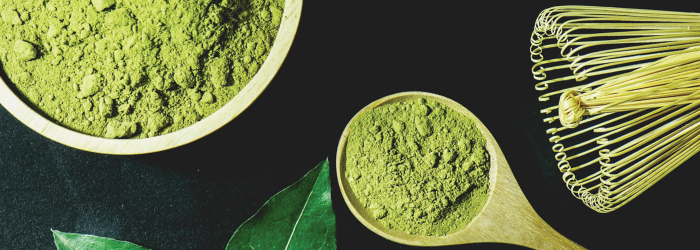What is Matcha Tea?

Released to public domain by owner. via Pixabay.
Matcha, or powdered green tea, has become Japan’s most famous type of tea. Originally adapted from powdered teas popular in China during the Tang Dynasty, Japanese matcha has since evolved into an utterly unique type of tea, central to the precise and complex Japanese Tea Ceremony. Today, it is popular worldwide, and used in many non-traditional ways, like matcha lattes or baked goods.
Origins & History
Put simply, matcha is made of green tea leaves which have been dried and milled into a fine powder. This tea-making technique has it’s roots in the earliest Chinese teas, for which leaves were steamed and compressed, then broken apart and ground. Rather than infusing the leaves in the water before straining them away, the small particles of tea are whisked into suspension in the hot water.
Released to public domain by owner. via Pixabay.
Though this type of tea was replaced by whole leaves in China, powdered tea remained popular in Japan thanks to its integral part in the Japanese Tea Ceremony. Instigated by Buddhist monks, and further refined by the samurai class, the ceremonial tea service became a paragon of formality, with each moment and impression carefully curated by the host. With practiced technique, the tea is whisked into a frothy suspension, and each guest takes a turn sipping from the bowl.
Matcha Quality
Since the finely powdered leaves are consumed as a part of the finished tea, matcha is more concentrated in both caffeine and antioxidants than infused tea. The potential health benefits have been one cause behind the tea’s skyrocketing popularity. But as with any tea, levels of quality can vary.
Traditional, or ceremonial, matcha is among the highest grades of Japanese green teas. First, the leaves are “shade grown”, or manually covered to reduce sun exposure before plucking. Then, the youngest spring buds are selected for plucking to ensure natural sweetness in the finished tea. The leaves are steamed, the stems carefully cut away, and then the remaining leaf is stone milled into the finished powder. Needless to say, the limited quantity of spring leaves and the labor-intensive processes make ceremonial matcha a rare commodity.
Many of the advantages associated with matcha are a direct result of these traditional processes. Shade-growing techniques have been shown to increase the levels of chlorophyll and L-theanine in the leaf, while young spring buds ensure that the final tea is naturally sweet, rather than bitter. Freshness is also important, since once the leaves are ground, exposure to oxygen can degrade the healthful properties and rich flavors within a matter of weeks. For context, whole leaf green teas with less exposed surface area will stay fresh as long as a year or two, if stored properly.
Modern Popularity
Released to public domain by owner. via Pixabay.
Today, most matcha available on the mass market is not of the ceremonial grade, but is instead “culinary grade”. These more accessible matcha powders are usually made with mature leaves picked later in the season, and may be ground without removing the stems. Overall, culinary grade matcha is more robust in flavor, with a tendency for bitterness. This makes it ideal for flavoring baked goods or lattes, but these flavored treats typically offset the potential health benefits with fats and sugar. Worst of all are “matcha” powders made mostly of sugar, which are more comparable to hot cocoa mix than to tea.
It’s easy to understand the appeal of dissolvable powder, though, as the process of making the whisked suspension requires practiced skill and specialized equipment. Temperatures above lukewarm can easily extract strong vegetal flavors, and a lazy whisk can result in an uneven suspension. It’s worth noting that matcha tea is not an everyday beverage in its native Japan. Though culinary matcha is a common flavoring in baked goods and candies, the whisking preparation is reserved only for extremely formal tea ceremonies. For everyday drinking, there are several grades of roughly chopped green teas, which are infused and strained just as in China.
We may be biased, but we typically prefer the soft, toasted flavor notes of roasted Chinese green teas over the savory grassiness of steamed Japanese greens. In addition, whole leaf teas offer a longer shelf life, all the same health benefits, and multiple infusions. To consume the leaves and get every last drop of healthful goodness, we recommend brewing a high quality Dragonwell like our Panan Supreme 2-3 times, and then eating the young, tender leaves straight from the cup, just as they do in Hangzhou. Or use your brewed leaves to make this decadent Dragonwell Pesto!
Sign up for our newsletter to get blog updates in your inbox!







Comments on this post (0)